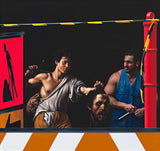Unframed
80 x 85 cm / 32" x 34"
Framed
106 x 101 cm / 42" x 40"
Oil on board
2018
Signed lower right
Collection, The Artist
Immediately apparent to followers of Watson's art is that this extraordinary work is the first to introduce a complete masterpiece by Caravaggio into a 21st Century scene, as apposed to introducing contemporary models painted within the classical work - an important and significant development in the Australian artist's ouvre.
Once again, and without altering the Renaissance artist's composition or proportions, Watson has created a compelling scene with his first reference of Caravaggio's iconic 'David with the Head of Goliath' integrated into a construction scene featuring a ruggedly, masculine plumber and iconography we immediately associate with warning and danger.
Caravaggio famously spotted many of his subjects in the street and many of these were working class men and women. Watson photographed this plumber working in the street near his Melbourne home. His expression is tense as he eyes David, and subtle but discernible splatters of blood on his arms render his inclusion in the scene convincing. Strongly reinforcing the violent tension in the classical reference.
The fluorescent road worker sign evokes Caravaggio's street workers, and Watson's strategically placed gold and white arrows draws the viewer's eyes upwards, whilst David's clenched left hand forms a powerful visual triangle with the white diagonal bands below.
In 1616, The Prince of Wales, who became King Charles I of England bought Caravaggio's David with the Head of Goliath, ironically, his eventual death was by beheading. This painting of 'David' was Caravaggio's last painting of a young man called Cecco, whom he had painted several times.






